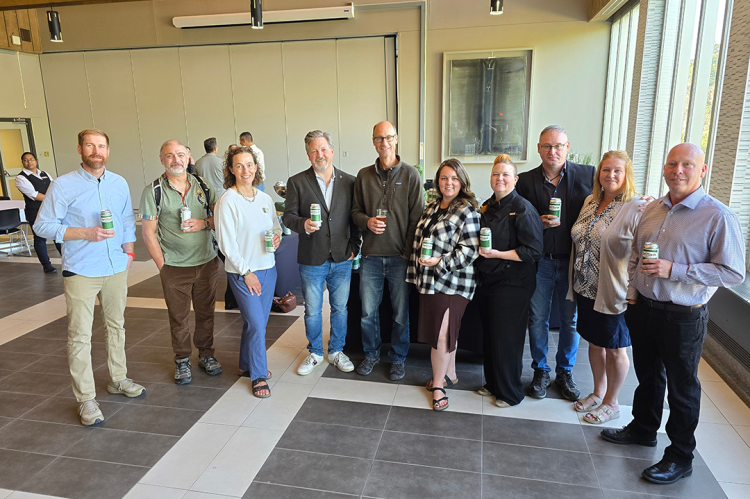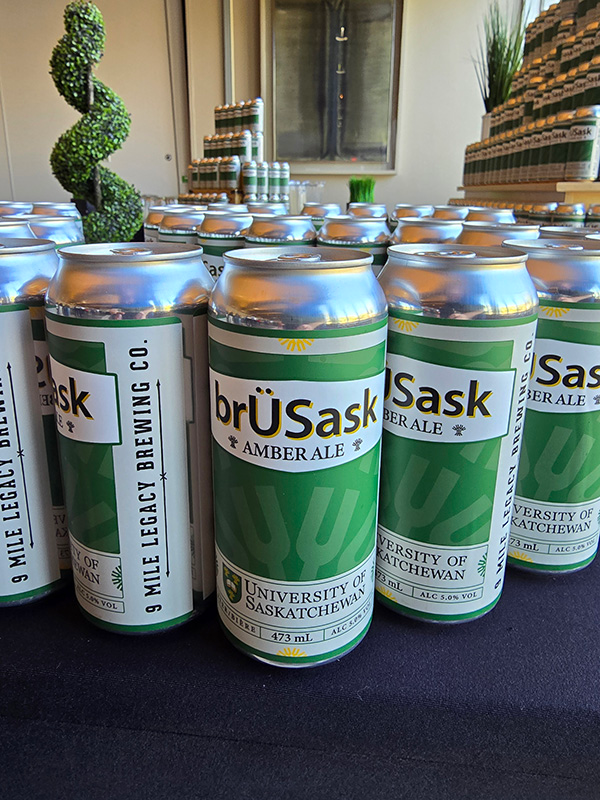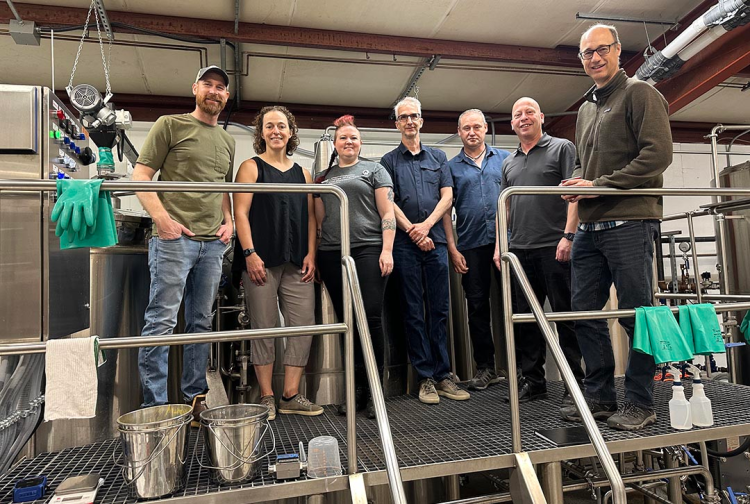A unique collaboration at the University of Saskatchewan (USask) is showcasing how leading-edge research can make real-world impact.
BrÜSask, a USask-branded beer for campus events, brings together three worlds: the food culture of USask Culinary Services, the discovery-driven work of USask researchers, and the industry expertise of a local brewing company. The product showcases USask in a unique way as a proof point of research excellence made tangible. But the real story is how these worlds came together to highlight the reach and relevance of USask research in a form people can connect with.

Collaborators celebrate during the brÜSask project at the launch event on September 22, 2025. (Photo: Matt Olson)
Here are five things to know about brÜSask:
1. The spark was lit by USask graduate student Fina Nelson

BrÜSask brings together the food culture of USask Culinary Services, the discovery-driven work of USask researchers, and the industry expertise of a local brewing company. (Photo: Matt Olson)
BrÜSask began in the mind of Fina Nelson, a PhD candidate in the Department of Food and Bioproduct Sciences at USask's College of Agriculture and Bioresources (AgBio). With more than two decades of research experience at USask, Nelson now focuses her doctoral work on yeast. She explores how the genomics of brewing yeasts drive the complex flavours and aromas that are at the centre of brewing the qualities every beer is judged by, and the ones craft brewers constantly push to reinvent and explore.
From the vantage point of her research, Nelson had a vision to showcase Saskatchewan-grown ingredients alongside Saskatchewan-grown research. She saw a way to align academic research with local industry connections through a project that created something people could understand, share, and experience.
"I saw such huge potential to communicate the excellence and global impact of research at the University of Saskatchewan in a way that combined some of the worlds I am most passionate about," said Nelson.
With the concept of a campus-served beer that showcased agricultural research, Nelson reached across her network to assemble the collaborators who could make it real.
To bring the idea to life, she brought together her PhD supervisor and IntelliYeast co-founder Dr. Christopher Eskiw (PhD), whose company is where her research has been translated into a commercial reality; Culinary Services manager James McFarland; and Cassy Appelt, director of LGCY: Innovation Hub at local brewing company 9 Mile Legacy.
"I love collaborating with the brewing community because they are a beautiful combination of scientists and artists," said Nelson. "They explore the world through hypotheses, experiments, and evaluations, while having a deft hand for breathing life into everything they do with their creativity and joy. It's the same type of passion that researchers bring to the lab bench."
2. Culinary Services saw the chance to bring research to the table
For McFarland, who plays dual roles at Culinary Services as manager and executive chef, brÜSask represents something rare: research and industry brought onto campus in a form people can experience: something that tells an active and unifying story of the university community while strengthening ties to the broader Saskatoon community.
Culinary Services is the place where those stories meet real people, from faculty and staff at campus functions to international guests welcomed through hosted events. With brÜSask licensed for service at those occasions, it offers the opportunity for research to become part of the conversations and experiences that shape the lived culture of USask.
"This project is exciting and unique in many ways," said McFarland. "Culinary Services hosts people from all industries and from all over the world. BrÜSask gives me the opportunity to point directly to the value of the work people at the university do, and it's such a great way to start conversations about the impact research across campus literally has across the world.
"It also highlights how food and hospitality can integrate and support our university. It makes me excited about the menus and services we build for events on campus, and it renews my passion for continually bringing partnerships and innovation into what we're creating here in Culinary Services."
McFarland sees brÜSask as the beginning of something bigger. Instead of a one-off project, brÜSask was created as a platform that can grow over time. Its future lies in expanding the kinds of research it highlights, moving beyond yeast to include other disciplines and stories.
3. USask researchers put agriculture and food science at the core of brÜSask
At its core, brÜSask is anchored in the science of agriculture and food. The project draws on collaborators from across AgBio, where researchers are advancing everything from yeast genomics and hop breeding to crop science and soil health. By connecting those discoveries with something as familiar as a beverage, the project demonstrates how research shapes what we eat and drink every day.
For Dr. Angela Bedard-Haughn (PhD), dean of the College of Agriculture and Bioresources, the collaboration celebrates the successes of the USask community.
"When I talk about the strength, breadth, and diversity of the research we do in AgBio, I often refer to how we work along the entire value chain," said Bedard-Haughn.
"The brÜSask project is a great example of that, whether we're talking about barley that was bred at the Crop Development Centre (CDC) and grown by local farmers, or agronomic practices that are enhancing sustainability and soil health where that barley is grown, or yeast that was designed by our scientists to optimize the brewing process or opportunities created in the local economy by partnering with local businesses, or even how brewers' by-products can be used as animal feed."
The inaugural brÜSask product features brewing yeast research led by Eskiw and barley breeding research by Dr. Aaron Beattie (PhD). Plant scientist Dr. Timothy Sharbel (PhD), who has developed a large collection of Saskatchewan-based hops, was also involved in the discussions.
Eskiw's research investigates how differences in each yeast strains' genetics influences the different flavor profiles in specific styles of beer. Through this research he has also developed novel ways to grow yeast that leads to increased fermentation rates while maintaining superior flavour characteristics. To commercialize his research, Eskiw co-founded IntelliYeast Labs with support from Opus, USask's startup incubator which provides free support to students, faculty and staff interested in developing businesses or building business skills.
The barley breeding program at the CDC has a long history of producing malting barley varieties that bring value to the western Canadian barley industry. Led by Beattie, the program conducts basic research focused on the genetic basis of disease resistance, agronomics and malt quality to create resilient varieties that meet the needs of growers, maltsters and brewers.
Most of the malt barley used to brew brÜSask comes from Maker's Malt in Rosthern, Sask. The malt house is owned and operated by USask alumnus Matt Enns, who grows and malts his own barley, a vertically integrated approach that gives him a rare perspective on the crop from seed to finished malt.
Maker's Malt initially worked primarily with CDC Copeland but now incorporates newer varieties like CDC Fraser and CDC Churchill, and has experimented with the hulless CDC Clear variety for malt research and food export.
"We have a dual and unique perspective on these barley varieties," said Enns. "From an agronomic standpoint, we see how new varieties show clear improvements in traits like standability and yield. From a malting perspective, we're equally focused on how those varieties perform through processing-balancing quality outcomes, ease of handling, and the needs of brewing customers, which ultimately sets the pace for how quickly new varieties make their way into the market."
4. LGCY: Innovation Hub made the brÜSask collaboration possible
The brÜSask project needed a space designed to take ideas from vision to practice, and it found its home in LGCY: Innovation Hub. Launched by 9 Mile Legacy Brewing in May 2024, the Innovation Hub is a facility that uses brewing as a platform for experimentation. It exists for exploration, where questions from the lab can be tested through brewing.
"I've worked in different areas of biotechnology since about 2019," said Appelt, director of LGCY: Innovation Hub. "Projects like brÜSask capture what unites biotechnology as a whole: connecting research with things that people benefit from. In this case, it's an agri-food product you can see, hold, and enjoy.
"It's exciting to work on a project that translates research immediately, but I'm really looking forward to finding more USask research to showcase in future iterations. Who knows, maybe the next batch isn't beer at all, but a completely new fermented beverage."
5. BrÜSask is an example of how home-grown research supports sustainability

From left: Garret Pedersen (9Mile), Dr. Angela Bedard-Haughn, Fina Nelson, Hamish Tulloch, Dr. Christopher Eskiw, Chef James McFarland, and Dr. Aaron Beattie. (Photo: Submitted)
Saskatchewan is an export-driven province, known for sending its raw agricultural products out into the world. BrÜSask flips that script by showing what can happen when innovation is cultivated and celebrated here at home. Research across USask is driving more sustainable ways to grow, use, and add value to ingredients like barley a crop that Canada is now recognized for producing with the lowest environmental footprint in the world.
This project highlights how sustainability can be advanced across the value chain. In AgBio, researchers are creating new knowledge to improve yields, resilience, and resource efficiency. At the manufacturing level, companies like IntelliYeast and 9 Mile Legacy are embedding circular economy practices into their operations, while Culinary Services is finding ways to showcase local, responsibly produced ingredients on campus. Together, they tell a story of environmental action that is grounded in Saskatchewan: recognizing the opportunities homegrown research "germinates" and creating value with Saskatchewan values at the forefront.
Ultimately, brÜSask demonstrates how research leads to better utilization of what is grown here, connecting innovation on the farm, in the lab, in the brewery, and at the table. It is a reminder that the future of sustainability is not only about exporting more raw product, but about building the knowledge and partnerships that make our food system stronger and more resilient.












